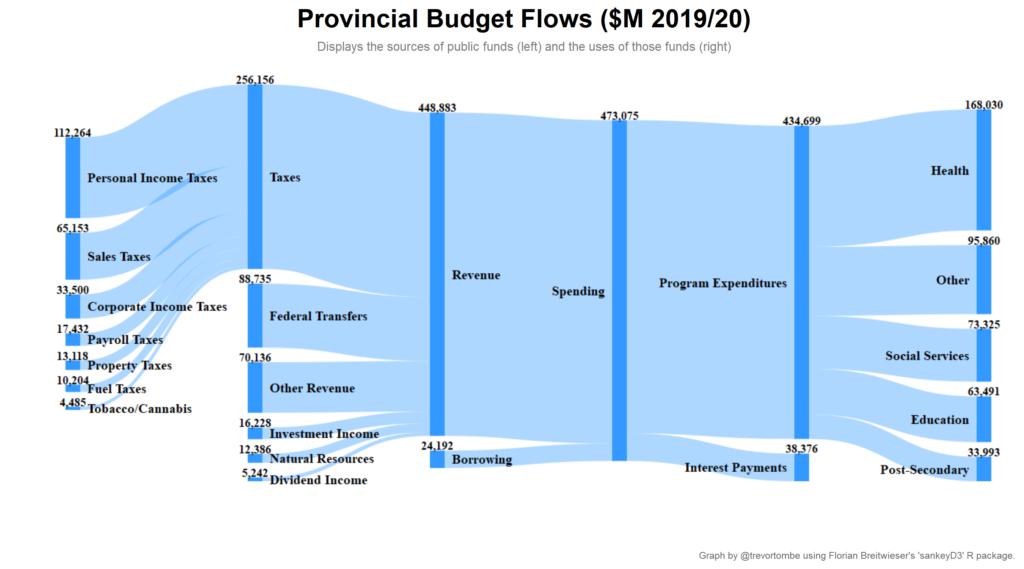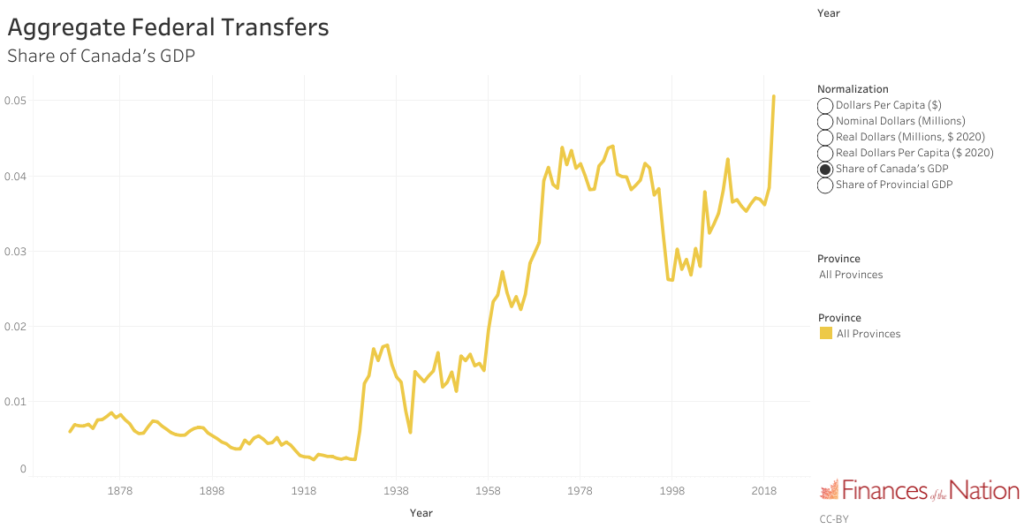Trevor Tombe
While the economic and fiscal disruptions from COVID-19 were substantial, provincial government finances fared far better than many anticipated. The latest data from Statistics Canada reveals the scale of the shock — with important implications for not only provinces, but also the federal government.
When the scale of the COVID-19 pandemic became clear in early spring 2020, most analysts — including myself — anticipated significant declines in government revenues. As individual incomes, business profits and consumer spending declined, government revenues from taxation surely would as well.
In August 2020, for example, I provided a preliminary (though of course uncertain) estimate of a nearly $35 billion revenue decline — equivalent to $1,000 per capita. I wasn’t alone.
But earlier this week, Statistics Canada reported comprehensive and comparable government financial statistics for 2020-21 for the first time. Finances of the Nation’s own revenue and expenditure database (available here) is now updated as well. Though revisions appear likely, it provides the best look yet at the state of provincial finances during the worst of the pandemic. Rather than a $35 billion hit, it appears provincial and territorial government tax revenues declined by less than $4 billion (or less than 1.4 per cent) and total revenues including all sources actually increased, despite the pandemic.
This post will explain why the fiscal cost to provinces was relatively light, as well as what role the federal government played (and will play) in the story.
Provincial finances and COVID-19
To appreciate how COVID-19 affects government budgets, it’s worth starting with a broad picture of where provincial revenues come from and what public services they fund. The figure below plots the aggregate of all provincial revenues and program expenditures in 2019/20 — right before the pandemic hit. (These numbers may differ slightly from the FoN database, but the reasons don’t matter here.)

Roughly half of revenues come from taxes, with most of the rest being transfers from the federal government and other revenues (fees, fines, sales of goods and services, and so on). With many businesses shut and individuals working less, there was considerable concern that taxation revenues would drop rapidly in 2020.
On the other side of the budget, health and education account for a majority of provincial government program expenditures. Health costs (unsurprisingly) increased dramatically during the pandemic, which significantly strained provincial budgets. Overall, total provincial expenditures increased by more than $55 billion in 2020-21 compared to 2019-20 — an increase of nearly 12 per cent.
But offsetting this increase in spending were revenue increases as well. Provinces have the federal government to thank for two main reasons.
First, federal transfers to provincial governments increased dramatically. At approximately five per cent of Canada’s national GDP, transfers today are higher than at any point in Canadian history. I illustrate this below.

In dollar terms, this increase exceeded $23 billion in additional grants to provincial governments. Most of this was the $19 billion “Safe Restart Agreement” that funded a whole range of activities, but was mostly aimed at offsetting rising health-care costs and supporting testing and contact tracing activities.
Second, massive federal income supports to individuals and business (mainly through CERB and CEWS) resulted in large increases in the income tax base for provinces. For perspective, federal social benefits and business subsidies increased by nearly $200 billion in 2020-21 over the prior year. These benefits were mostly taxable income, which helped cushion the pandemic’s fiscal hit to provinces. Individuals receiving CERB benefits, after all, have to pay income taxes on that income, including to provincial governments. So rather than a decrease in tax revenues, provinces saw income tax revenues increase by more than $5.8 billion in 2020-21 compared to 2019-20 — a (welcome) development that few anticipated early on.
Not all revenues sources increased, to be sure. Total provincial revenues from taxes on goods and services fell by nearly $10 billion. While individual incomes rose, spending on many taxable services (like restaurants) fell sharply throughout the pandemic. But overall, across all provincial revenue sources, total revenues increased nearly $12 billion — or 2.6 per cent above 2019-20 levels. I display all the top-level changes below.
| Table 1: Provincial-Territorial Government Revenues and Expenditures | |||
| Millions of Dollars | |||
| Province | 2019/20 | 2020/21 | % Change |
| Personal Income Taxes | 106,926 | 110,103 | +3.0% |
| Corporate Income Taxes | 32,187 | 34,790 | +8.1% |
| Consumption Taxes | 101,929 | 92,228 | -9.5% |
| Payroll Taxes | 30,611 | 29,638 | -3.2% |
| Property Taxes | 13,161 | 14,161 | +7.6% |
| Transfers | 99,204 | 122,555 | +23.5% |
| Other Revenue | 71,007 | 63,465 | -10.6% |
| Total Revenue | 455,025 | 466,940 | +2.6% |
| Program Expenditures | 432,992 | 489,498 | +13.1% |
| Debt Service | 38,429 | 37,286 | -3.0% |
| Total Expenditures | 471,421 | 526,784 | +11.7% |
| Budget Deficit | 16,396 | 59,844 | +265.0% |
| Total Liabilities | 1,259,831 | 1,362,179 | +8.1% |
| Source: own calculations from Finances of the Nation government revenue and expenditures database. Total liabilities from Statistics Canada data table 10-10-0017-01. | |||
These changes in provincial finances also have future implications for federal spending through a rarely used, though recently expanded, transfer program.
Federal stabilization payments
With provincial revenues buffered by the federal government — directly through transfers and indirectly through (taxable) support to individuals and businesses — additional federal support through Canada’s “Fiscal Stabilization Program” may be significantly less than previously thought.
Some background may be helpful. Since 1967, the federal government has implicitly insured provincial governments against sudden and significant declines in revenues. Originally, if provincial revenue fell by more than five per cent, then the federal government would cover any additional declines beyond that. Over time, however, several reforms under successive federal governments limited the scale and scope of this support to provinces. (For more, see this.)
Following the pandemic, the pressure to expand this program mounted, so in its November 2020 fiscal update, the federal government effectively tripled the amount of support the program could provide to qualifying provinces. (For more, see this.) But to qualify, total provincial revenues (from certain sources) needed to first fall by more than five per cent. Most provinces were spared such dramatic declines.
In the following table, I report the changes in taxation revenues for each province. This is not precisely how the stabilization program works — since there are adjustments made if provinces (such as Alberta) changed tax rates, not all sources of taxation revenues are included, and other revenues (such as natural resource revenues) are included elsewhere in the formula — but this is close enough for illustrative purposes. Overall, provincial taxation revenues fell only 1.9 per cent. Only four provinces saw declines in excess of five per cent: Nova Scotia, Manitoba, Saskatchewan and Alberta. The largest provinces of Ontario and Québec actually benefited from modest tax revenue increases.
| Table 2: Provincial Government Taxation Revenues | |||
| Millions of Dollars | |||
| Province | 2019/20 | 2020/21 | % Change |
| Newfoundland and Labrador | 3,961 | 4,020 | +0.7% |
| Prince Edward Island | 1,107 | 1,150 | +3.9% |
| Nova Scotia | 6,934 | 6,432 | -7.2% |
| New Brunswick | 5,433 | 5,261 | -3.2% |
| Québec | 75,799 | 76,291 | +0.6% |
| Ontario | 112,583 | 112,008 | -0.5% |
| Manitoba | 9,511 | 8,935 | -6.1% |
| Saskatchewan | 8,826 | 7,863 | -10.9% |
| Alberta | 23,832 | 21,961 | -7.9% |
| British Columbia | 35,624 | 34,192 | -4.0% |
| Total | 283,640 | 278,113 | -1.9% |
| Source: own calculations from Finances of the Nation government revenue and expenditures database. Total excludes territorial governments. | |||
This matters a lot for stabilization payments. Currently, the federal government provides payments for revenue declines beyond five per cent but only up to a pre-determined cap— currently at approximately $169 per-capita. Based on the numbers above, it appears total stabilization payments may be only slightly more than $1 billion — with three-quarters of that going to Alberta alone. This is considerably less than the nearly $6.5 billion payment that would have happened if all provinces qualified for the maximum level of support. Interestingly, of the fiscal benefits to provincial governments that the November 2020 reform will now provide, nearly 85 per cent will go to Alberta and Saskatchewan.
Conclusion
Of course, the fiscal and economic dust from COVID-19 has not fully settled and future revisions and analysis will be necessary to paint a full picture. But the latest data reported in the Finances of the Nation government revenue and expenditures database reveals that Canada’s provincial finances got through the pandemic with a stronger fiscal position than many feared. Thanks largely to the federal government.
